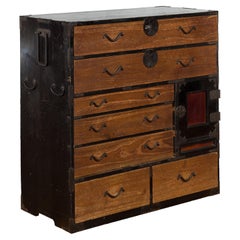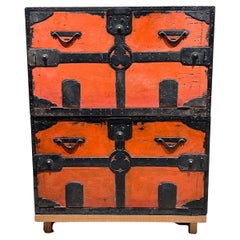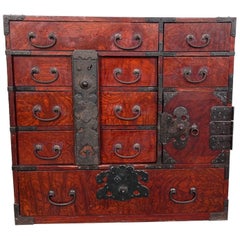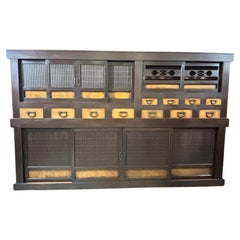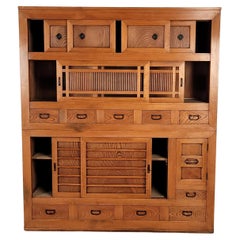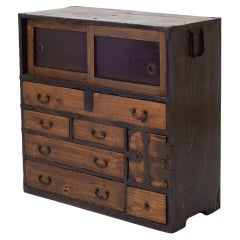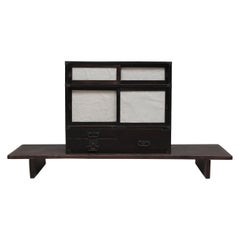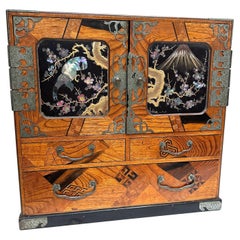Meiji Tansu
Antique 19th Century Japanese Meiji Commodes and Chests of Drawers
Wood
Early 20th Century Japanese Anglo-Japanese Cabinets
Metal
Antique 1890s Japanese Furniture
Iron
Antique Late 19th Century Japanese Meiji Furniture
Chestnut, Cypress
Early 20th Century Japanese Meiji Furniture
Wood
Antique Late 19th Century Japanese Meiji Cabinets
Iron
Antique 19th Century Japanese Meiji Commodes and Chests of Drawers
Iron
Antique 19th Century Japanese Meiji Cabinets
Cedar, Pine, Paper
Antique Late 19th Century Japanese Meiji Furniture
Wood, Mother-of-Pearl, Lacquer
Antique Late 19th Century Japanese Meiji Commodes and Chests of Drawers
Iron
Antique Late 19th Century Japanese Meiji Commodes and Chests of Drawers
Iron
Antique 19th Century Japanese Meiji Sideboards
Cedar
Antique Late 19th Century Meiji Furniture
Hardwood, Burl
Early 20th Century Japanese Meiji Commodes and Chests of Drawers
Iron
Antique 1870s Japanese Meiji Furniture
Wood
Antique Late 19th Century Japanese Meiji Cabinets
Iron
Early 20th Century Japanese Japonisme Commodes and Chests of Drawers
Iron
Antique 19th Century Japanese Meiji Cabinets
Iron
Antique 1870s Japanese Meiji Cabinets
Iron
Antique Late 19th Century Japanese Meiji Cabinets
Elm
Antique Late 19th Century Japanese Meiji Side Tables
Iron
Antique Late 19th Century Japanese Meiji Side Tables
Iron
Antique 1880s Japanese Meiji Furniture
Iron
Antique 19th Century Japanese Meiji Commodes and Chests of Drawers
Iron
Antique Late 19th Century Japanese Meiji Lacquer
Lacquer
Antique Late 19th Century Japanese Meiji Cabinets
Iron
Antique Late 19th Century Japanese Meiji Commodes and Chests of Drawers
Cedar
Antique Late 19th Century Japanese Meiji Commodes and Chests of Drawers
Cedar
Antique Mid-19th Century Japanese Meiji Furniture
Iron
Early 20th Century Japanese Meiji Commodes and Chests of Drawers
Metal, Iron
Antique Late 19th Century Japanese Meiji Commodes and Chests of Drawers
Iron
Antique Late 19th Century Japanese Meiji Commodes and Chests of Drawers
Wood
Antique 19th Century Japanese Meiji Furniture
Iron
Antique Late 19th Century Japanese Meiji Cabinets
Cedar
Antique Late 19th Century Japanese Meiji Commodes and Chests of Drawers
Iron
Antique Late 19th Century Japanese Furniture
Wrought Iron
Antique Late 19th Century Japanese Furniture
Wrought Iron
Antique Late 19th Century Japanese Furniture
Iron
Antique Late 19th Century Japanese Furniture
Iron
Antique Late 19th Century Japanese Meiji Furniture
Iron
Antique Late 19th Century Japanese Furniture
Iron
Antique Mid-19th Century Chinese Meiji Commodes and Chests of Drawers
Iron
Early 20th Century Korean Meiji Furniture
Metal
20th Century Japanese Meiji Furniture
Metal, Brass
Early 20th Century Japanese Meiji Cabinets
Iron
Antique Late 19th Century Japanese Meiji Commodes and Chests of Drawers
Iron
Early 20th Century Japanese Meiji Cabinets
Iron
Early 20th Century Japanese Meiji Cabinets
Chestnut, Cedar
Early 20th Century Japanese Meiji Commodes and Chests of Drawers
Cedar
Early 20th Century Japanese Meiji Commodes and Chests of Drawers
Cedar
Antique 1880s Japanese Meiji Commodes and Chests of Drawers
Iron
Antique Late 19th Century Japanese Meiji Cabinets
Cedar
Antique 19th Century Japanese Meiji Chandeliers and Pendants
Brass, Iron
Early 20th Century Japanese Meiji Cabinets
Iron
Early 20th Century Japanese Meiji Sideboards
Cedar
Early 20th Century Japanese Meiji Cabinets
Cedar
Early 20th Century Japanese Meiji Commodes and Chests of Drawers
Cedar
Early 20th Century Japanese Meiji Cabinets
Cedar
- 1
- ...
Meiji Tansu For Sale on 1stDibs
How Much is a Meiji Tansu?
A Close Look at Meiji Furniture
From 1868 to 1912, Emperor Mutsuhito oversaw an era of transformation in Japan. Formerly a country of feudalism and isolation, Japan entered an age of modernization influenced by newly established trade and exchange with the West. The Meiji period, or period of “enlightened rule,” also saw the global impact of the East Asian country’s culture. Japanese Meiji furniture was exhibited at expositions from Paris to San Francisco and created for export.
Prior to the Meiji era, furniture was mostly made by commission for the ruling class; now there were new domestic and international markets. European styles like Japonisme appropriated Japanese design while craftsmen in places like Wales and England employed japanning, a varnishing technique that approximated the appearance of lacquer for the surfaces of furnishings.
Meiji furniture made for Japanese homes and buildings constructed in Western styles resulted in taller tables, chairs, cabinets with large drawers and other features. The government invested in areas such as transportation and communication, and because people could freely choose occupations after the restrictions of feudalism, industries of various types were energized by expressive new ideas during those years. Art schools were formed and, for the first time, design was an area of study in the country, leading to the evolution of professional design as a career by the 1890s.
The work of Japanese designers was transmitted widely through lavishly illustrated pattern books that included designs for screens and lacquerware for the home. While screens today may be of use as decorative accents or partitions to ensure privacy in one’s space, Japanese screens were adorned with paintings and were featured in performing arts such as concerts, tea ceremonies and more. The color illustrations that characterize Meiji woodblock prints, a genre of Japanese art that grew out of 17th-century developments in printing and book publishing, depicted the sweeping changes that the era brought to East Asia.
Although it was a time of societal and cultural shifts, a bolstered interest in art and design elevated Japanese craft traditions. From colorful porcelain table lamps with silk shades and hardwood tables decorated with dark lacquer to cabinets featuring iron hardware and inlaid with mother-of-pearl, Meiji furniture showcased Japan’s artistic heritage to the world.
Find a collection of antique Japanese Meiji period case pieces and storage cabinets, decorative objects, wall decorations and more furniture on 1stDibs.
Finding the Right Case Pieces And Storage Cabinets for You
Of all the vintage storage cabinets and antique case pieces that have become popular in modern interiors over the years, dressers, credenzas and cabinets have long been home staples, perfect for routine storage or protection of personal items.
In the mid-19th century, cabinetmakers would mimic styles originating in the Louis XIV, Louis XV and Louis XVI eras for their dressers, bookshelves and other structures, and, later, simpler, streamlined wood designs allowed these “case pieces” or “case goods” — any furnishing that is unupholstered and has some semblance of a storage component — to blend into the background of any interior.
Mid-century modern furniture enthusiasts will cite the tall modular wall units crafted in teak and other sought-after woods of the era by the likes of George Nelson, Poul Cadovius and Finn Juhl. For these highly customizable furnishings, designers of the day delivered an alternative to big, heavy bookcases by considering the use of space — and, in particular, walls — in new and innovative ways. Mid-century modern credenzas, which, long and low, evolved from tables that were built as early as the 14th century in Italy, typically have no legs or very short legs and have grown in popularity as an alluring storage option over time.
Although the name immediately invokes images of clothing, dressers were initially created in Europe for a much different purpose. This furnishing was initially a flat-surfaced, low-profile side table equipped with a few drawers — a common fixture used to dress and prepare meats in English kitchens throughout the Tudor period. The drawers served as perfect utensil storage. It wasn’t until the design made its way to North America that it became enlarged and equipped with enough space to hold clothing and cosmetics. The very history of case pieces is a testament to their versatility and well-earned place in any room.
In the spirit of positioning your case goods center stage, decluttering can now be design-minded.
A contemporary case piece with open shelving and painted wood details can prove functional as a storage unit as easily as it can a room divider. Alternatively, apothecary cabinets are charming case goods similar in size to early dressers or commodes but with uniquely sized shelving and (often numerous) drawers.
Whether you’re seeking a playful sideboard that features colored glass and metal details, an antique Italian hand-carved storage cabinet or a glass-door vitrine to store and show off your collectibles, there are options for you on 1stDibs.
